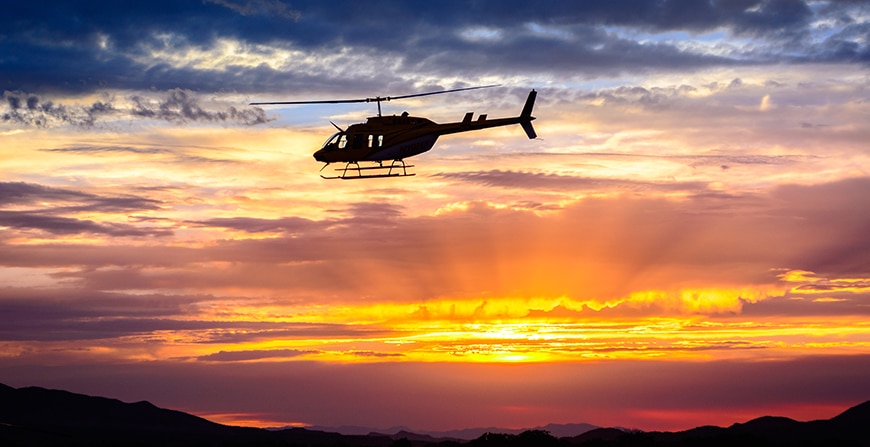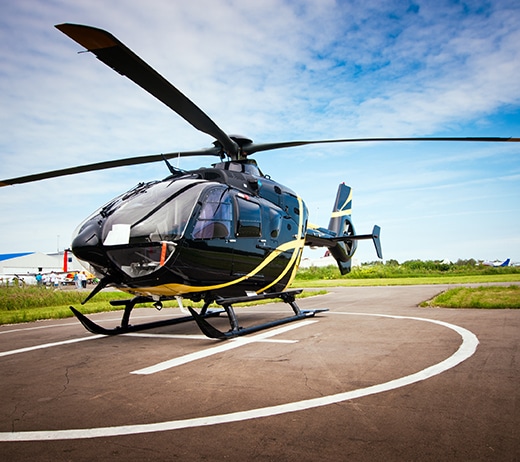
Helicopter Tour Crash Attorneys
Attorneys Who Will Fight for Justice for Helicopter Tour Crash Victims and Their Families
A growing number of tourist destinations now offer sightseeing helicopters which provide travelers with spectacular views and a new perspective. Unfortunately, there are many risks associated with this type of flight because many pilots don’t go through the extensive training required of their commercial counterparts, weather conditions can change quickly, and terrain and conditions can be both unique and challenging. In addition, a shortage of helicopter pilots and mechanics often results in poorly maintained equipment and less qualified individuals in the cockpit.
What some passengers assume will be an exceptional experience can suddenly turn tragic in the event of an accident, with resulting life-altering injuries, and even death. If you or a family member has been involved in a helicopter tour crash, you can rely on the team of compassionate attorneys at Slack Davis Sanger to help bring you the justice and compensation that you deserve, while also fighting for industry reforms.
Involved in an Accident?
We're Ready to Help
Perils of Helicopter Tours
According to the National Transportation Safety Board, 128 helicopter sightseeing accidents occurred from 2001 to 2010—an alarmingly large number. In 17 of these incidents, there were fatalities. Because helicopters are designed to move in all directions and hover, this type of aircraft is less stable than a plane and is equipped with more navigational features. More moving parts means more risks, which is unfortunate, since these types of aircraft have fewer restrictions on maintenance and pilot training minimums.
Other reasons that helicopter tour passengers are at a higher risk for life-altering injury, and even death, in the event of an accident include:
- Greatly reduced visibility when flying at night
- Some models aren’t equipped with doors, and/or have difficult-to-release safety harnesses
- Rough terrain and unlevel ground makes an emergency landing difficult
- Inadequate safety regulations
Managing partner, Ladd Sanger, is a licensed helicopter pilot who understands the complexities of helicopters, as well as many other types of aircraft. He leads our team of helicopter accident attorneys and writes extensively regarding new regulations and aircraft safety.

Causes of Helicopter Tour Accidents
There are many factors that can play a role in a helicopter accident and help explain why this mode of transportation can be more dangerous.
The most common reasons helicopter tours are involved in serious accidents include:
- Inadequate helicopter maintenance if tour operators prioritize profits over passenger safety
- Pilot error, such as failing to adequately fuel up before the flight, losing control of the helicopter, or failing to spot an obstacle, such as a tree or a mountainside
- Pilot distraction
- Sudden weather changes that affect stability and visibility
- Inexperienced or improperly trained pilots
- Manufacturer defects
Since a majority of all aviation accidents occur on takeoff or landing, and helicopters tend to do both more frequently than other types of aircraft, these accidents are even more likely. While Federal Aviation Administration (FAA) officials have encouraged a move towards tighter regulations for pilots and helicopter manufacturers, not enough is being done to prevent these tragedies.
If you or a family member has been involved in a helicopter tour crash, you can turn to the compassionate aviation accident attorneys at Slack Davis Sanger to seek justice. With decades of experience and licensed pilots leading the charge, our team understands the complexities of helicopters. We also have the resources at our disposal to help you fight for the compensation you deserve while advocating for changes to prevent future tragic accidents.
Human Error in Helicopter Crashes
The term “pilot error” includes various mistakes a pilot may make while operating any type of aircraft. These mistakes include both tactical errors, which are the result of poor decision making, and operational errors, which are the result of poor training. Helicopter tour pilots in particular are at a higher risk of making these types of misjudgments which can often lead to catastrophic consequences.
However, human error is not limited to helicopter tour pilots. Air traffic controllers, as well as those that maintain helicopters, can be found liable in helicopter tour crashes. As is the case in other types of aviation accidents, human error is the most common cause of a helicopter tour crash.
A few examples of poor judgment that can lead to an otherwise avoidable helicopter tour accident include:
- Insufficient planning prior to flight take off, including not cancelling tours due to poor weather conditions
- Inadequate communication with air traffic controllers
- Insufficient fuel prior to taking off
- Pilots with improper training flying helicopters with features they are unfamiliar with
Helicopter Crashes in Hawaii
With volcanoes, cliffs, and beaches, Hawaii is a popular spot for helicopter tours. What visitors may not realize, however, is that the weather changes frequently and without much warning, making it difficult to predict when conditions will be unsafe for a tour. Additionally, because of the differences in terrain, pilots must understand the unique microclimates that exist in the areas in which they fly to better ensure a safe flight. Helicopters that take off during or after sunset do so with more limited visibility for the pilot, adding an additional layer of danger onto what is already a hazardous mode of transportation.
Unfortunately, helicopter tour companies may use less expensive helicopters in order to increase profits. This often means purchasing aircraft with fewer safety features or a more dangerous track record. The Robinson R-44 is one example of a cost-effective helicopter model utilized by many Hawaiian helicopter tour companies. More than 600 fatalities have been linked to this type of aircraft since 1982. Over 65 wrongful death and product liability lawsuits have been filed against Robinson for ignoring safety issues with these helicopters, including a number filed by attorneys at Slack Davis Sanger.
Grand Canyon Helicopter Crashes
The jagged edges and cliffs in the Grand Canyon can lead to unpredictable gusts of wind that are strong enough to push a helicopter off its path. With steep canyons, inexperienced pilots, and heavy air traffic, the Grand Canyon frequently makes news headlines for helicopter tour crashes.
While there are more restrictions on helicopter tours in the Grand Canyon, many unregulated helicopter tour companies have found loopholes that allow them to take visitors around the park without violating FAA rules. With anywhere from 350 to 400 reservations a day for these helicopter tours, regulators are struggling to enforce existing regulations.
In fact, the Federal Aviation Administration was created in response to a midair collision that occurred in the Grand Canyon back in 1956. Since its inception, the FAA has outlawed flights that dip below the Canyon rim and mandated a fifty-foot buffer zone between aircraft and potential obstacles. Even with the FAA’s efforts, dangerous conditions still exist and accidents are taking place all too often with heartbreaking results.
Specialized Knowledge in the Aviation Industry
Our team of helicopter crash attorneys is made up of licensed pilots and a former NASA aerospace engineer, allowing us to have a better understanding of what happened in these tragedies and how to prevent future disasters. Our skilled lawyers work tirelessly for our clients to bring them the justice they deserve. We are compassionate and attentive, and have the resources needed to seek compensation from those who were responsible so victims and their families can focus on what can be a long and emotional recovery. We have tried and settled aviation cases in 47 different states and can bring this extensive knowledge to your case.
What to Know Prior to Boarding a Tour Helicopter
If you are planning on taking a helicopter tour, there are some precautions you can take to help lower your risks. When doing your research, keep the following in mind:
- Look for a company with a good safety rating and reputation. Ideally, look for a helicopter tour provider that is certified as an FAA Part 135 Air Carrier, which means they are held to higher standards than other non-certified helicopter tour companies.
- Use the Federal Aviation Administration Accident & Incident Data report or the NTSB’s Aviation Accident Database to search for any accidents the helicopter tour company may have been involved with.
- Read through pilot information on helicopter tour websites. Ask for a pilot with extensive experience and review their qualifications.
- Check weather reports leading up to the day of your tour to ensure clear skies. Opt not to take the tour if the weather is questionable.
- With helicopter tours, choose a company with experience over one that is less expensive. Operators with lower prices often have aircraft with fewer safety features and less experienced pilots.
Although you can never be guaranteed safe travels when aboard a helicopter tour, performing proper research could make a world of difference.
Fighting for justice for victims of helicopter tour crashes and accidents
Flightseeing tours are rife with risks, and changes in the industry are slow to come. Slack Davis Sanger takes its commitment to creating a safer air tour industry seriously. If you or your loved one was injured in a helicopter tour crash or accident, we are standing by to help. To schedule a free case review with an experienced aviation accident attorney, please call 800-455-8686 or fill out our contact form.
Frequently Asked Questions
What are the main reasons helicopters crash?
When there is a helicopter accident, the cause is most often linked to human error by the pilot, a mechanical problem, or an electrical malfunction. Although most aviation accidents are blamed on human error, in these cases, there are usually other factors in play. Human error could be decision-based, skill-based, or perceptual. In the case of a 2016 accident involving a helicopter air ambulance, which claimed the life of the four individuals on board, the pilot made an error when opting to carry out a mission despite weather condition ratings falling below minimum levels. Engine failure was to blame for a 2018 fatal helicopter crash in New York City, which resulted in five deaths. Two contractors were killed and a helicopter pilot was injured in Pennsylvania in 2018 after an accident involving workers stringing power lines.
What types of compensation can victims of helicopter crashes and their families seek?
Due to the complex nature of aviation law and the intricacies of helicopter regulations, obtaining just compensation for individuals involved in these accidents and their loved ones rests on having a skilled legal team working on your behalf. Compensation can include medical costs, physical pain, disfigurement, physical limitations, loss of earning capability, and mental anguish.
How much will I need to pay an attorney to pursue my claim?
Slack Davis Sanger works on a contingency basis for helicopter crash cases. That means the firm charges no fees to our clients unless we make a successful recovery. We cover all the upfront costs of filing and litigating the lawsuit on behalf of our clients. If we obtain a recovery, Slack Davis Sanger is reimbursed for our expenses and takes a fee, which is a pre-determined percentage of the recovery that the client agrees to when the firm is hired. This fee covers office overhead, staff time, and attorney time. The fee and reimbursed expenses are deducted from the settlement or award. The amount of the contingent fee charged depends on the complexity and risk associated with your claim.
How long will it take for my case to reach the settlement phase?
Unfortunately, there is no easy answer to this question, since every case is different. While our team does all we can to work swiftly toward a resolution, aviation cases are extremely complex. The investigative phase can take weeks, months, or years as we endeavor to develop the best strategy for pursuing justice on behalf of our clients. Once this initial research phase is complete, our clients can expect to have a better understanding of next steps and the overall timeline.
